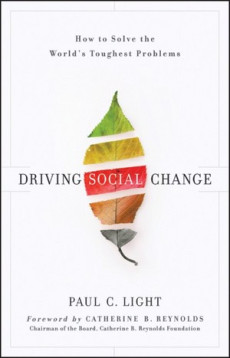
Driving Social Change: How to Solve the World’s Toughest Problems
Paul C. Light
208 pages, John Wiley & Sons, 2011
Paul Light’s new book Driving Social Change: How to Solve the World’s Toughest Problems is the latest contribution to a rich, ongoing dialogue about how to usher in social breakthroughs.
Light presents a methodology for creating lasting social change, and he begins his book with three research questions: Has the field placed too much emphasis on the individual social entrepreneur, thereby defining social entrepreneurship as the primary source of social innovation? Are there other, equally powerful drivers of social progress? And finally, how are social breakthroughs achieved? Light devotes a chapter to each question, all of which feed into his “breakthrough cycle,” a nine-stage process that outlines the “moves from inputs, activities, and outputs to a new social equilibrium.”
Light’s line of inquiry stems from previous works—“Reshaping Social Entrepreneurship” (2006) and The Search for Social Entrepreneurship (2008)—although his contention is no longer that social entrepreneurship is a little-understood term but that its role has been overestimated as a driver of social change. He argues that the tendency to promote an exclusive definition of social entrepreneurship has prevented the field from forging necessary partnerships. In contrast, he defines social entrepreneurship loosely as “an essential but not exclusive driver” that “can be found almost anywhere.”
To broaden the field’s approach to social problem solving, Light highlights three additional drivers he believes have been neglected—social exploring, social advocacy, and social safekeeping. Each has a specific function: Social explorers assess the present social climate and identify opportunities for change; social advocates use political channels and grassroots movements to maximize pressure points; and social safekeepers (Light’s name for social service providers) transform social breakthroughs into common practice, while also preserving past progress.
When assessing which driver is best suited to address a particular problem, he argues that the choice of driver must align with the desired outcome. Light also believes that social breakthroughs are more attainable when all four drivers exert pressure in tandem “to create the irritation needed for disruption.” His breakthrough cycle relies on eight other elements, such as a commitment to change and an assessment of assets and obstacles.
Light says his book is based on the idea that social entrepreneurship is “neither the only driver in agitating the prevailing wisdom, nor always the best choice in addressing urgent threats.” In the breakthrough cycle, he limits the contribution of social entrepreneurship to the introduction of a new combination of ideas. He also notes that in some cases, this contribution is “irrelevant” for the type of breakthrough needed.
My experience is that the role of the social entrepreneur is both more distinctive and more comprehensive than the phenomenon Light describes. Other drivers are indisputably essential. At the same time, I have witnessed that powerful innovators and organizations undertake many of the activities assigned to social explorers, advocates, and safekeepers. Nonprofits such as Citizen Schools, College Summit, Stand for Children, Year Up, YouthBuild, and Youth Villages (some of which are supported by my organization, New Profit) are social entrepreneur-led organizations that have achieved large-scale impact through policy change, major public-private partnerships, grassroots advocacy, and new service delivery techniques.
Light challenges social entrepreneurs to “join the fight already under way throughout society,” but we are already seeing traction on this front. Cross-sector partnerships like the 100,000 Homes Campaign, the Strive Partnership, and the Education Equality Project all take collaboration seriously while embracing a robust understanding of what various change agents bring to the table.
Driving Social Change will appeal to many who are pioneering new ways to solve old problems, whether through young or established organizations, advocacy efforts, or research. In particular, Light’s presentation of the social breakthrough cycle surfaces many of the components needed for transformative social change, while also leaving room for exploration into how the components work together and the additional elements needed to make change possible.
Light is right that the problems facing us globally are too big for any one person or method to solve. Partnerships are necessary, as are multifaceted approaches that use diverse tactics for social change. We need to learn from the partnerships that are already testing the type of collaboration Light calls for in Driving Social Change. I look forward to the day when we stop debating the pros and cons of social entrepreneurship and move on to better aligning our resources. Then we can actually solve some of the world’s toughest problems together.
Vanessa Kirsch is the president and founder of New Profit Inc., a venture philanthropy fund based in Cambridge, Mass. She has more than 20 years of experience in developing innovative solutions to social problems and is widely recognized as a leading social entrepreneur.

